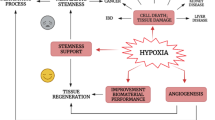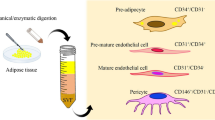Summary
Adipose-derived stem cells (ASCs) induce therapeutic angiogenesis due to pro-angiogenic cytokines secretion. Superparamagnetic iron oxide (SPIO) nanoparticles are critical for magnetic resonance (MR) tracking of implanted cells. Hypoxia is a powerful stimulus for angiogenic activity of ASCs. In this study, we investigated whether therapeutic potency could be enhanced by implantation of hypoxia-preconditioned SPIO-labeled ASCs (SPIOASCs) into the infarcted myocardium. ASCs and SPIOASCs were cultured under 2% O2 (hypoxia) or 95% air (normoxia). Cells were intramyocardially injected into the infarcted myocardium after 48-h culture. We found that hypoxia culture increased the mRNA expression of hypoxia-inducible factor-1 alpha (HIF-1α) and vascular endothelial growth factor (VEGF) in ASCs and SPIOASCs. The VEGF protein in the conditioned medium was significantly higher in hypoxic ASCs and SPIOASCs than in normoxic ASCs and SPIOASCs. The capillary density and left ventricular contractile function in the infarcted myocardium were significantly higher 4 weeks after implantation with hypoxic ASCs and SPIOASCs than with normoxic ASCs and SPIOASCs. Improvement in the capillary density and left ventricle function didn’t differ between hypoxic ASCs-transplanted rats and hypoxic SPIOASCs-transplanted rats. Hypoxic culture enhanced the angiogenic efficiency of ASCs. It was concluded that implantation of hypoxic ASCs or SPIOASCs promotes therapeutic angiogenesis and cardiac function recovery in the infarcted myocardium. SPIO labeling does not impact the beneficial effect of hypoxic ASCs.
Similar content being viewed by others
References
Zuk PA, Zhu M, Mizuno H, et al. Multilineage cells from human adipose tissue: implications for cell-based therapies. Tissue Eng, 2001,7(2):211–228
Rehman J, Traktuev D, Li J, et al. Secretion of angiogenic and antiapoptotic factors by human adipose stromal cells. Circulation, 2004,109(10):1292–1298
Wang J, Xiang B, Deng J, et al. Inhibition of viability, proliferation, cytokines secretion, surface antigen expression, and adipogenic and osteogenic differentiation of adipose-derived stem cells by seven-day exposure to 0.5 T static magnetic fields. Stem Cells Int, 2016,2016:7168175
Wang J, Xiang B, Deng J, et al. Externally applied static magnetic field enhances cardiac retention and functional benefit of magnetically iron-labeled adipose-derived stem cells in infarcted hearts. Stem Cells Transl Med, 2016,5(10):1380–1393
Bai X, Yan Y, Song YH, et al. Both cultured and freshly isolated adipose tissue-derived stem cells enhance cardiac function after acute myocardial infarction. Eur Heart J, 2010,31(4):489–501
Wang L, Deng J, Tian W, et al. Adipose-derived stem cells are an effective cell candidate for treatment of heart failure: an MR imaging study of rat hearts. Am J Physiol Heart Circ Physiol, 2009,297(3):H1020–H1031
Chi C, Wang F, Xiang B, et al. Adipose-derived stem cells from both visceral and subcutaneous fat deposits significantly improve contractile function of infarcted rat hearts. Cell Transplant, 2015,24(11):2337–2351
Wang JA, Chen TL, Jiang J, et al. Hypoxic preconditioning attenuates hypoxia/reoxygenation-induced apoptosis in mesenchymal stem cells. Acta Pharmacol Sin, 2008,29(1):74–82
Dai Y, Xu M, Wang Y, et al. HIF-1alpha induced-VEGF overexpression in bone marrow stem cells protects cardiomyocytes against ischemia. J Mol Cell Cardiol, 2007,42(6):1036–1044
Mao X, Zeng Q, Wang X, et al. Angiogenic potency of bone marrow stromal cells improved by ex vivo hypoxia prestimulation. J Huazhong Univ Sci Technolog Med Sci, 2004,24(6):566–568
Han YS, Lee JH, Yoon YM, et al. Hypoxia-induced expression of cellular prion protein improves the therapeutic potential of mesenchymal stem cells. Cell Death Dis, 2016,7(10):e2395
Liu J, Hao H, Xia L, et al. Hypoxia pretreatment of bone marrow mesenchymal stem cells facilitates angiogenesis by improving the function of endothelial cells in diabetic rats with lower ischemia. PLoS One, 2015,10(5):e0126715
Hill JM, Dick AJ, Raman VK, et al. Serial cardiac magnetic resonance imaging of injected mesenchymal stem cells. Circulation, 2003,108(8):1009–1014
Blaber SP, Hill CJ, Webster RA, et al. Effect of labeling with iron oxide particles or nanodiamonds on the functionality of adipose-derived mesenchymal stem cells. PLoS One, 2013,8(1):e52997
Wang L, Deng J, Wang J, et al. Superparamagnetic iron oxide does not affect the viability and function of adipose-derived stem cells, and superparamagnetic iron oxide-enhanced magnetic resonance imaging identifies viable cells. Magn Reson Imaging, 2009,27(1):108–119
Hsiao ST, Lokmic Z, Peshavariya H, et al. Hypoxic conditioning enhances the angiogenic paracrine activity of human adipose-derived stem cells. Stem Cells Dev, 2013,22(10):1614–1623
Efimenko A, Starostina E, Kalinina N, et al. Angiogenic properties of aged adipose derived mesenchymal stem cells after hypoxic conditioning. J Transl Med, 2011,9:10
Wang X, Liu C, Li S, et al. Hypoxia precondition promotes adipose-derived mesenchymal stem cells based repair of diabetic erectile dysfunction via augmenting angiogenesis and neuroprotection. PLoS One, 2015,10(3):e0118951
Stubbs SL, Hsiao ST, Peshavariya HM, et al. Hypoxic preconditioning enhances survival of human adipose-derived stem cells and conditions endothelial cells in vitro. Stem Cells Dev, 2012,21(11):1887–1896
Zuk PA, Zhu M, Ashjian P, et al. Human adipose tissue is a source of multipotent stem cells. Mol Biol Cell, 2002,13(12):4279–4295
Cerrada I, Ruiz-Saurí A, Carrero R, et al. Hypoxia-inducible factor 1 alpha contributes to cardiac healing in mesenchymal stem cells-mediated cardiac repair. Stem Cells Dev, 2013,22(3):501–511
Kim SH, Moon HH, Kim HA, et al. Hypoxia-inducible vascular endothelial growth factor-engineered mesenchymal stem cells prevent myocardial ischemic injury. Mol Ther, 2011,19(4):741–750
Huang B, Qian J, Ma J, et al. Myocardial transfection of hypoxia-inducible factor-1a and co-transplantation of mesenchymal stem cells enhance cardiac repair in rats with experimental myocardial infarction. Stem Cell Res Ther, 2014,5(1):22
Author information
Authors and Affiliations
Corresponding authors
Additional information
This work was supported by the National Natural Science Foundation of China (No. 81200105), the Scientific Research Foundation of Wuhan Union Hospital (No. 02.03.2017-34), the Natural Science Foundation of Hubei Province of China (No. 2015CFB457), the China Postdoctoral Science Foundation (No. 20100470050), Canadian Institute of Health Research (CIHR) (No. 200806RMF-189873-RMC-CDAA-42533), and National Research Council of Canada (NRC).
Rights and permissions
About this article
Cite this article
Wang, J., Xiang, B., Deng, Jx. et al. Hypoxia enhances the therapeutic potential of superparamagnetic iron oxide-labeled adipose-derived stem cells for myocardial infarction. J. Huazhong Univ. Sci. Technol. [Med. Sci.] 37, 516–522 (2017). https://doi.org/10.1007/s11596-017-1766-0
Received:
Revised:
Published:
Issue Date:
DOI: https://doi.org/10.1007/s11596-017-1766-0




